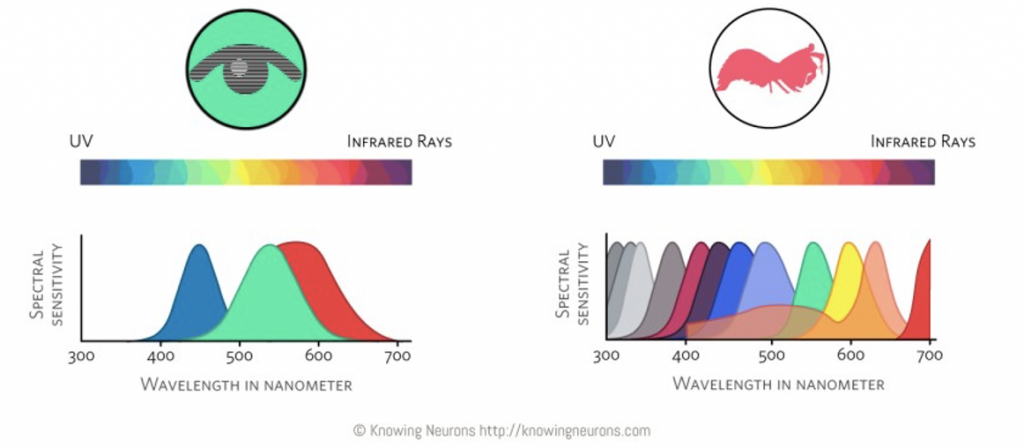It came to mind magenta in some form of what doesn't exist. I have a little back round in photography and film developing. Take note of the the color of the lady what she is wearing. What are the chances the wardrobe decided to match the car. There are similar results using daylight film under florescent lights, a green over cast. A trick on the eye or a reaction of the film or could be something else. monitor.
The mantis shrimp and its ability to see color like no other animal on the planet. Mantis shrimp (Stomatopoda) are brightly colored crustaceans that live on reefs. They are commonly known among fisherman as “thumb splitters” because of their hammer-like claws which can deliver blows that accelerate as fast as a .22-caliber bullet.
Researchers have long known that the mantis shrimp eye contains 12 color receptors, but they had no idea why (Pappas, 2020). On the other hand, humans and most other animals use three color-receptors to see the visible portion of the electromagnetic spectrum. To observe the visible spectrum, light receptors within the eye transmit messages to the brain, which then produces color (Color intelligence, 2020).
Fig. 1. Comparison of human vision vs. mantis shrimp vision. (Fehlhaber, 2020)
One of the first thoughts I had while learning about the mantis shrimp was whether they could see and perceive colors which humans can’t even conceive. Is there a whole other rainbow out there with various colors that we just can’t see? Apparently not: turns out, there are six colors that we can see that technically don’t exist.
Before all else, it is important to establish that the color magenta is just an illusion created by our eyes. This purplish-red-crimson color, located between red and blue on the color wheel, is extra special as it is not found on the visible spectrum of light and there is no wavelength of light that corresponds to that particular color. Rather, it is physiologically and psychologically perceived as a mixture of red and blue. So technically, magenta doesn’t exist.
Our eyes have receptors called cones for three different colors: red, green, and blue. By combining the three colors in different ways, secondary colors can be created. For example, a combination of blue and red makes purple. The way this works is that if the eye reports the red and blue receptors being stimulated, the brain also processes the absence of green (How to See Colors That Don’t Exist, 2020). This is not only important for being able to interpret colors immediately, but also it allows the brain to correct for different color temperatures. For instance, our brains report white paper as white even if it were under a blue light, despite only activating the blue receptors. Because of this process, we can enable ourselves to see colors which don’t really exist.
By exploiting this fact about how our eyes work and exposing our eyes to bright primary or secondary colors, we can saturate the corresponding cones and thus block out other signals. Looking at the opposite color on the color wheel will then produce a color that is oversaturated – a color that is imaginary (How to See Colors That Don’t Exist, (2020). The effect soon fades, however, as the brain readjusts to the normal world.
Researchers have criticized this possibility of impossible colors as they believe these are just intermediary colors between two color cones (Pappas, 2020). However, we do know that people have seen colors that they have never seen before. So, I guess it’s safe to say that impossible colors may not exist, but it’s definitely possible to trick our brain into seeing new hues.
The link below brings you to a website where you can try to see all the imaginary colors.
View a gallery of the colors here!
The nonexistent colors that you can see, and the colors needed to see them, are as follows:
To see supermagenta, look at green.
To see superblue, look at yellow.
To see supergreen, look at magenta.
To see superred, look at cyan.
To see superyellow, look at blue.
To see supercyan, look at red.
For example, to see superblue, stare at pure yellow for a minute or so, then immediately look at blue. The blue should appear bluer than normal.
References:
Pappas, S. (2020). Aggressive Mantis Shrimp Sees Color Like No Other. Retrieved 20 September 2020, from
Aggressive Mantis Shrimp Sees Color Like No Other
Color Intelligence. (2020). Retrieved 20 September 2020, from
https://www.pantone.com/color-intelligence/articles/technical/how-do-we-see-color
How To See Colors That Don’t Exist. (2020). Retrieved 20 September 2020, from
How To See Colors That Don’t Exist





















